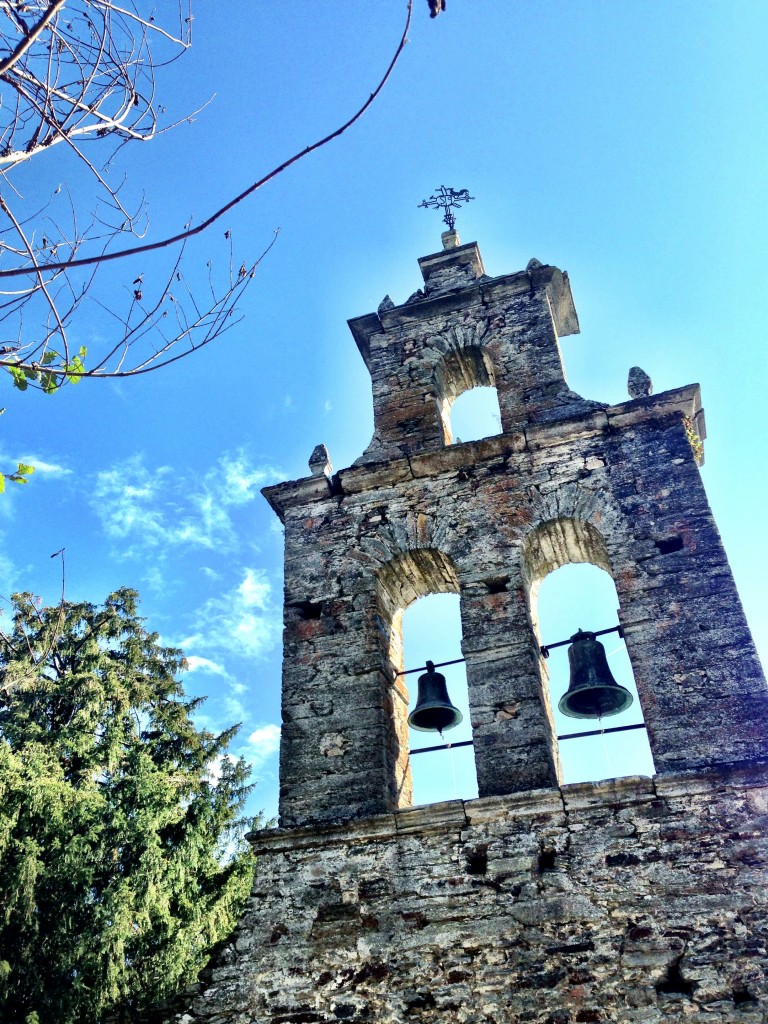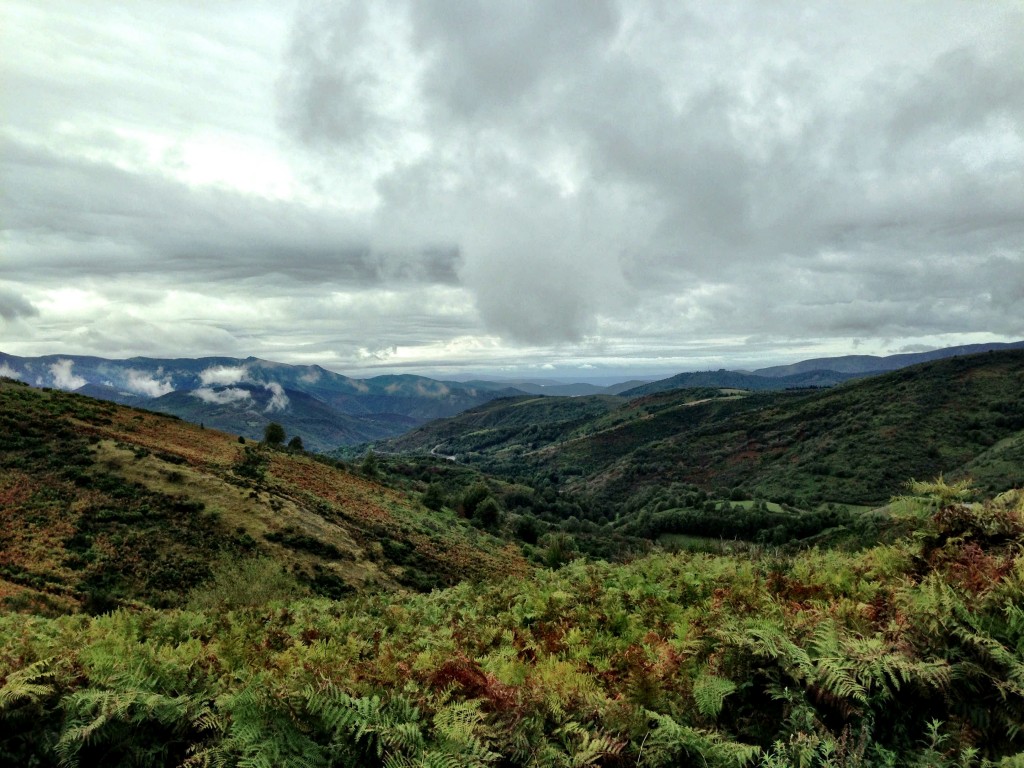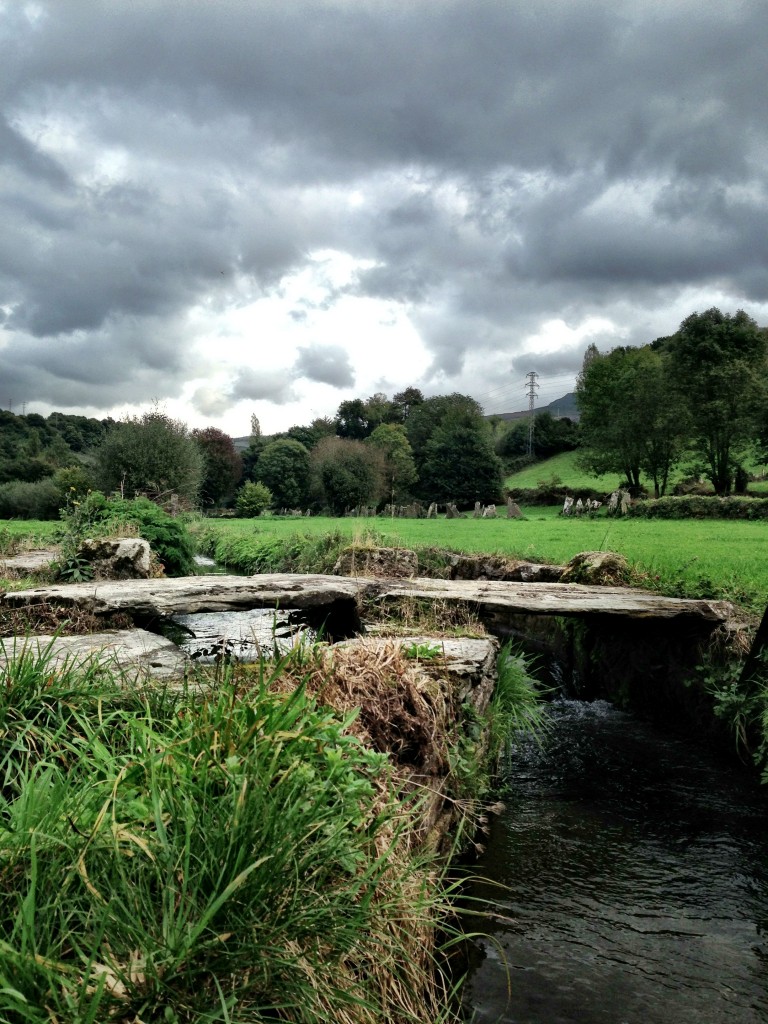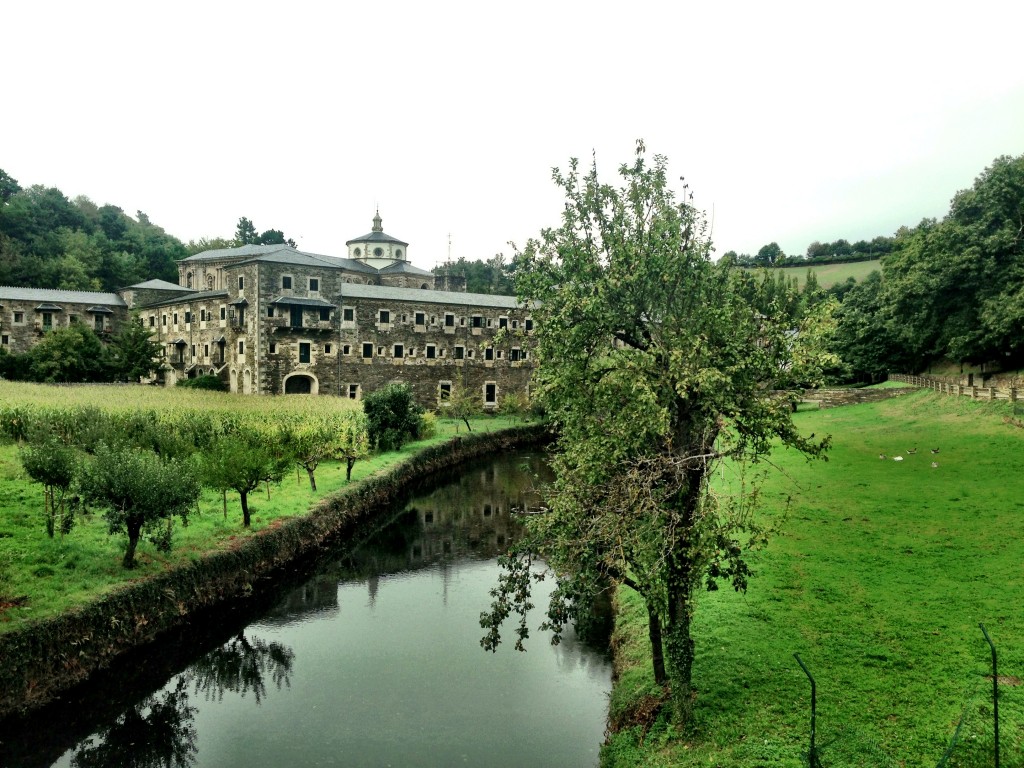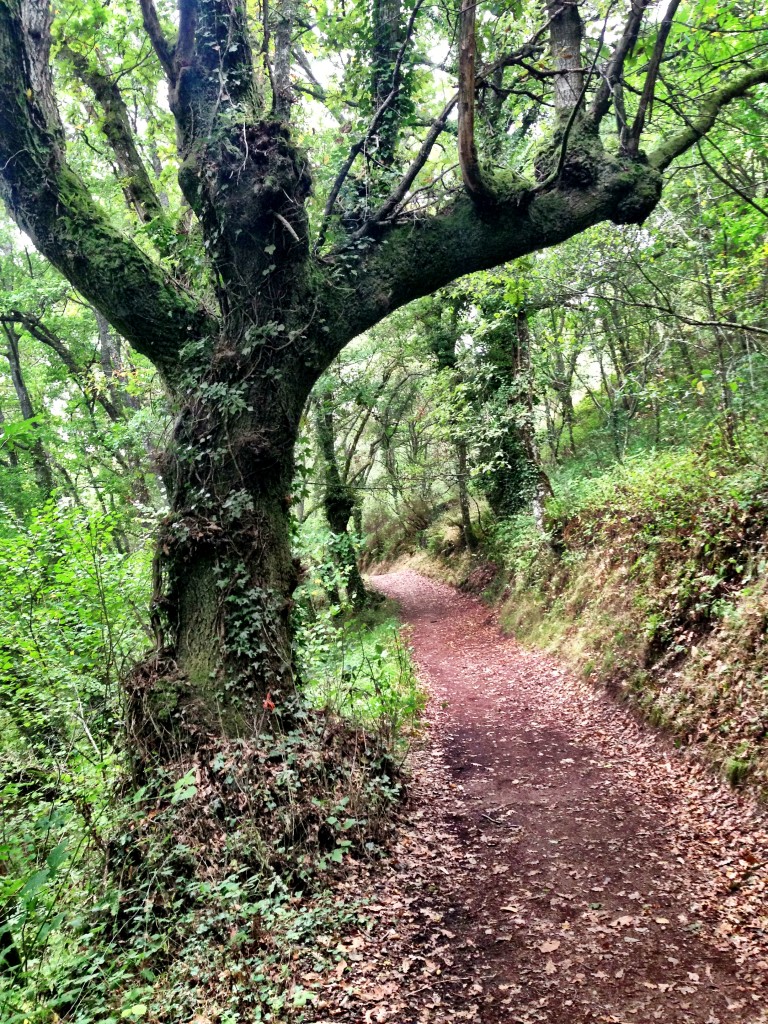There are 2 options when leaving Villafranca del Bierzo. For those that don’t like steep climbs there’s the Valcarce Valley offering a flat alternative. Unfortunately it’s right next to a busy road and over the last couple of weeks, albeit on and off, I really have had my fill of roads. The other option is the Camino Duro which climbs steeply at first and then relaxes into just a hard slog. As with all uphill’s though, the rewards are far greater.
Church tower near Pereje
Villafranca was lost once more and the hum of the Valcarce died to nothing. I saw no one save my companion Veronic but as is often on the Camino, you’re never more than a few miles from anywhere but you could be in the middle of nowhere. It was now half way through October but it could have been the middle of Summer. Down there it was hazy but up here it was pin point focus clear. The foliage, still vibrant and green stretching up to meet a turquoise sky interspersed with a few lazy clouds, almost yawning. Chestnuts in full harvest drop their fruits everywhere and I munch contentedly until they are no more and the oaks appear, descending to pines. Ancient stone walls lose an occasional piece to the trail which I step over.
Pereje came out of nowhere. I remember getting lost here on my last visit. This time, as if they already knew (or perhaps remembered?) the locals called out and pointed the way up a short incline but not before I had to stop to allow a cow and cart passage. Chickens scattered as the local café emerged from a side street and the owner chattered away in Spanish to me despite my “Yo no habloespañol”.
The Camino Duro looked after us for half a day at least as the path steepened down once more to the valley below. A quiet country road weaved along crossing the same river many times. Every few miles a small hamlet appeared with no signs of life in the afternoon. Even the siesta, an escape from the fierce heat of the summer, was being abused well into the now cooler air of the autumn.
The hardest climb after the Route Napoleon is O Cebreiro at 1300 metres (4265 feet). I knew what to expect (it’s not anywhere near as bad as we are led to believe) but I smirked as I passed a few others the following morning discussing the ‘huge’ and ‘massive’ mountain they now had to tackle. That’s the thing with the Camino; you never really go into mountain territory. It always stays green despite people’s fears of rocky wastelands and snow-capped monsters, it’s just isn’t like that. 1300 metres is about as high as it manages and once you’re up, as wonderful as it is, you could be in the middle of the English countryside. The myth struggles to live up to its reputation.
O Cebreiro on a misty morning
It had rained the previous evening so the path was damp. The wind had died in the early hours so a low cloud stole any view I was hoping for, at least until the upper reaches where it started to thin and lose its hold. Sun light filtered through and eventually won the battle as I became acquainted with my environment. Yellow flowers from gorse bushes and their coconut scent took me back to England and splashed of red from the rosehips coloured a grey day.
At the top the familiar round dwellings, or pallozas, signalled Cebreiro itself. Of Celtic origin people lived in these squat stone houses with their animals. Their conical roofs and an oval layout were still used up until the sixties but now they are used as museums and gift shops.
A further, short climb was the last of any ascents for that day at least as I rolled over and along narrow paths looking north across the hills until starting to drop down gently towards Tricastela. A stone marker told me I was now in Galicia, the sun was burning away the last of the damp as wafts of moisture rose from the hedgerows and stones gradually started to lose their shine. Everything was turning green as I ventured further into this last region of the Camino, vibrant grass lay at the feet of trees still fully clothed, albeit tinged with spots and patches of reds, yellows and browns. Ferns lined the path; brambles clung to walls and old farm buildings. The hills stretched away to my right, rolling and tumbling like a vast, emerald ocean.
I reached Tricastela at 3.30pm. Pilgrims sat outside eating and drinking, squinting and soaking up an autumn sun. It was early, too early for me to consider hanging up my shoes for the day. I waited patiently outside the local store for a few minutes until the owner arrived, jangling his keys aimlessly to find the right one to unlock the door. He greeted me, apologised for being a little late, at least that’s what I thought he said in French, I took his raised eyebrows, innocent expression and a gesture to his watch as a translation. I bought some fruit and nuts and sat on the pavement outside nibbling enough sustenance to take me a few more miles. I remembered the path by the side of a quiet road and set off to pull in a few more miles before calling it days end.
The River Oribio gently gushed next to me as I reached San Cristova do Real and disappeared off down a small side road which merged into a dirt track. I passed a Lavoir (old buildings where the locals used to wash their clothes), crossed over the river at Vigo do Real, nothing more than a collection of ageing farm buildings showing no signs of life except the occasional cat peering out through a crack in a barn door. Beautifully tunnelled woodland paths perched above the Oribio, I ran my hands over moss covered walls and gnarly oak bark watching the light play on the water. Leaves drifted down swaying from side to side like pendulums. A forester watched me curiously as I sat down my pack by a brook winding through a field to take pictures. The locals are a curious bunch in Spain, they think nothing of stopping their activities just to stare at you as if you can’t see them and when you eventually approach them and nod a greeting they jump in surprise and look bashful that they have been rumbled. It’s very peculiar.
Lavoir
Samos nestles in a crook in the surrounding hills. As I walked down the last lane of the day I peered over a hedge to see the Monastery de San Julian y Santa Basilisa commanding its position. Founded around the 5th / 6th centuries it is reputedly one of the oldest in the western world. Samos itself is a haphazard collection of old and new buildings but quite charming. A light rain started to fall as I reached the village and looked around aimlessly for the Alberge Val de Samos. Feeling somewhat like a tourist flicking through the guide book I realised after 5 minutes that it was right next to me. The proprietor saw me approach and opened the door, showed me around, warned me not to use one of the showers as it didn’t work and took my details. There were only 6 other pilgrims there which I found strange because Samos is 100 km (62.5 miles) from Santiago. Many pilgrims start here to walk the Camino and do the minimum required distance to achieve the certificate of completion from the cathedral authorities. Perhaps the rain had kept them away. Whatever it was I slept soundly with rain playing games on the windows.
Samos Monastary
There were two options the following day, a winding ten mile route that first went north and west, or a nine mile alternative along the road, albeit again a quiet one. The rain had not finished with me yet and with little life in any of the bars that morning I plumped for the road to get to Sarria, and breakfast that bit quicker. A fierce wind whipped from the side as I pulled my umbrellas down hard against me. After weeks of amazing weather I was starting to get a little aggrieved with being wet again.
Sarria is a drab place, acceptable in places but generally not worth stopping at. I found a bar and the owner rustled me up a hot chocolate and a fresh omelette, mopped up with some baguette. Following the railway line for a short while I disappeared off into the woods again with an occasional glance upwards to check on the clouds. A sign by the side of the path beckoned me on – 44 miles to Santiago. Mixing up an afternoon on farm tracks and forest paths gradually Portomarin came into view. The original town was lost after the River Mino was dammed in the 1960’s and after a dry summer, some of the old buildings poke hauntingly up from the depths. The new town is a modern version of trying to be old, it succeeds somewhat but in the back of my mind there was always the thought that it was fake. The only concession is the two churches – San Pedro and San Nicolas, which were moved, stone by stone, to their new positions.
It was late afternoon but Portomarin wasn’t calling me to stay. The Casa Garcia alberge in Gonza was selling itself well in the guidebook so I put my head down and set off for a final 5 miles as the sun was setting. 80 minutes later spurred on by a raging hunger and desperate need for G&T I found the Garcia by torch light. A very amenable host showed me the one spare bed left, asked me if I would like dinner and proceeded to make me said beverage with such a delicate touch it seemed a shame to drink it. She chinked a few ice cubes into a tumbler and swirled them around to chill the glass. Then, a lemon was carefully wiped around the inside and rim and another piece was placed in for good measure. She poured in a generous measure of Gin from an impressive height and handed me a bottle of tonic to finish off with my personal measurement.
Tomorrow, I would set out for the first of three, last days to reach Santiago.
The old buildings of a sunken Portomarin
